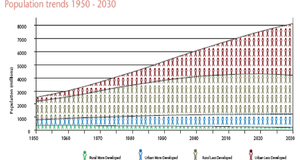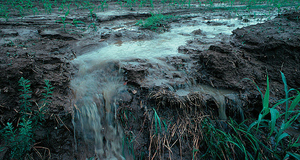From Earth Common Journal VOL. 3 NO. 2Selling Ourselves Short: A Discussion of Water-Markets in Alberta
IN THIS ARTICLE
KEYWORDS
AbstractThe issue of water management has become one of increasing importance. Any new policy regarding resource management must balance the needs of the environment, the municipalities, and industry. In an effort to reconcile these needs, this report reviews the best practices of water policy. Specifically, the reason for undertaking this report is to research policy options available to the Alberta government to provide a framework for improving the Water for Life strategy. One generalization that can be made across the spectrum of privatization models is that whenever a resource is labelled a commodity, the objective to sell it for a profit invariably undermines the aquatic ecology at the source. The report identifies a common practice in which industrial entities pay for water on a sliding scale, (if they are made to pay anything at all), with bulk water purchases becoming cheaper as more water is consumed. By applying a conservation-orientated system to industrial users, the minimum amount of water available would have heavy fees assigned when exceeding the allotment. An industrial system with the conservation-orientated approach could also add extra incentive to recycle water used for industrial purposes. A policy of conservation-orientated charging applied to municipalities and industry offers the practical aspects of water leases and conservation enforcement. Research finds that private ownership of water offers more detrimental than beneficial outcomes for the people of Alberta. IntroductionWe face an unassailable fact: we are running out of freshwater . . . In the last century we humans have so vastly expanded our use of water to meet the needs of industry, agriculture, and a burgeoning population that now, after thousands of years in which water has been plentiful and free, its scarcity threatens the supply of food, human health and global ecosystems. (Leslie as cited in Feldman, 2007, p. 6) Water is understandably necessary to sustain life, but should it ever constitute a commodity to sustain an economy? The issue of water privatization or water-markets has been raised before. A number of countries have already adopted various forms of water-markets—with mixed success. One generalization that can be made across the spectrum of privatization models is that whenever a resource is labelled a commodity, the objective to sell it for a profit invariably undermines the aquatic ecology of the source: “No sector in the world has become more conscious of the worth of water than the private sector, which sees a profit to be made from scarcity” (Barlow & Clarke, 2002, p. 73). Moreover, there is a persistent thought process tied with ‘water-as-commodity’ that consumers, even the poor, choose where they spend their money; in time we can expect to hear that people without water services just made bad choices (Barlow, 2012, p. 6). Alberta is in the process of reviewing its historical water allocation system, and one of the options being proposed is a market-based allocation system. The water allocation system currently in use has been in place for more than 100 years and limitations to this system have arisen (Government of Alberta, 2009, p. 9). Theoretically, market-based allocation ensures that the increasingly scarce resource (i.e., water) will be put to its highest and best use. The question that has yet to be adequately answered is whether the economic value of a resource has any bearing on its value to society. Industry has the ability to pay for water; does this mean that industrial growth is more important than providing clean water to municipalities? Water is arguably too valuable to have a price. And yet, by not assigning a monetary value to water, extensive and uncontrolled consumption is encouraged within our society. This unsustainable practice and behaviour needs to change. This paper is grounded in the premise that complete private ownership of a universal human necessity is unsound. The inherent costs and benefits of water-markets will be explored in this paper, and will provide a policy framework for updating Alberta’s water allocation system. Literature ReviewPrior to developing policy recommendations a review of the existing literature was conducted, as well as a close examination of the ‘Water for life: Action plan’ published by the Province of Alberta. International case studies were reviewed to determine best and worst practices in the areas of ecosystem conservation, sustainability, allocation of resources, financial implications, and business models. The literature review was the major instrument used in developing the policy guidelines. These literary sources were selected using two criteria:
A number of the sources, both academic papers and books, were authored by Maude Barlow. Her authority on the subject matter is undisputed, having received eleven honorary doctorates, a Citation of Lifetime Achievement at the 2008 Canadian Environment Awards, the 2009 Earth Day Canada Outstanding Environmental Achievement Award, the 2009 Planet in Focus Eco Hero Award, and the 2011 EarthCare Award, as well as serving as Senior Advisor on Water to the 63rd President of the United Nations General Assembly (Barlow, 2012, p. 1). Additionally, reports from independent, public policy research institutes such as the Parkland Institute and Pembina Institute were reviewed, as well as a selection of works detailing the economic operations of water-markets. In a report released by the Council of Canadians, Rahman, Barlow, and Meera (2011) indicate that Alberta is at risk from virtual water markets since the province has just two per cent of Canada’s water supply, yet accounts for two-thirds of the country’s water usage, towards irrigation, much of it for export through virtual water markets (p. 5). In this report, the concept of virtual water is explained as “the amount of water consumed in the production process of a good or service” (J.A Allan, 1993, as cited in Rahman, et al., 2011, p. 9). Building on this definition, the virtual water content (VWC) of products ranges greatly: a cup of tea (i.e., 250 ml) contains about 35 litres in VWC, a cup of coffee (i.e., 125 ml) is 140 litres, and a hamburger (i.e., 150 g) is 2,400 litres (Hoekstra & Chapagain, 2008, as cited in Rahman, et al., 2011, p. 10). The same principle applies to agriculture. The United States is able to offset their water requirements by importing high VWC products while exporting low VWC goods, causing an imbalance in trade and a net virtual water loss for Canada (p. 31). Agriculture exports a significant amount of water through virtual trade, although more ecologically damaging is the tar sands extraction in Northern Alberta. Water is used in the tar sands to extract bitumen from the sand. Bitumen has been deemed the worlds’ most water-intensive hydrocarbon—consuming a net average of three barrels of water to produce each barrel of oil (Dyer, Moorhouse, Laufenberg, Powell, 2008, & Nikiforuk, 2008, as cited in Rahman, et al., 2011, p. 21). The water consumed by this industry is taken out of the natural cycle and is destroyed—polluted beyond use. Presently, “the tar sands mines account for more than 76 per cent of the water allocations from the Athabasca River” (Rahman, Barlow &. Meera, 2011, p. 25). This is a significant drain on the Athabasca River. More detrimental is the reality that the water consumed is not able to be reclaimed: “Every year, the energy sector—all of it corporate and much of it foreign controlled—uses (and destroys) 1.1 billion cubic metres of freshwater in the production of oil from the tar sands . . . Alberta does not charge any money for access to this water” (Rahman, Barlow & Karunananthan, 2011, as cited in Barlow, 2012, p. 9). The practice of allowing free access to raw (untreated) water is a measure put in place to promote industrial growth, but it is a short-sighted policy that needs to end. Especially since new water-intensive methods of extraction such as hydraulic fracturing (also known as ‘fracking’ or hydro-fracking) are becoming more common. Hydraulic fracturing uses a solution made with water, sand, and chemicals which is injected at high pressure to fracture existing geological formations and force the oil or gas up the well (Rahman, et al., 2011, p. 26). A large contributing factor to the lack of conservation efforts is related to how our society allocates value. Unless there is a monetary value attached to something society seems to believe that it has minimal to no value. The Polis Project published a report, Worth Every Penny, A Primer on Conservation-Orientated Water Pricing, that suggests Canadians pay remarkably little for their water, noting that water consumption is remarkably high, and conservation-orientated charging could curb excess use. The report continues, explaining that under the current system with flat volumetric charging, you pay for the water you use—the more you use the more you pay. Implementing changes to the pricing may reduce consumption. Under conservation-orientated block charging the price is very low for basic water needs and then charges incrementally more per unit of water used (i.e Tier 1, 2, 3, etc). A visual representation of this incremental increase is shown in Figure 1. Simply put, the basic water you use is cheap; when you start to use more, you pay more per unit. The queston posed by the authors of the report is why should prolific users pay the same amount as those who do their best to conserve (Polis Project as cited in Barlow, 2012, p. 7)? Figure 1. Comparing conservation-orientated block charging with a flate rate. The concept of conservation-orientated charging is considered one of the most logical best-practices described in the literature.The strength of conservation-orientated policy is that it could also be adapted to industry. Industrial entities commonly pay for water on a sliding scale, (if they are made to pay anything at all) with bulk water purchases becoming cheaper as more water is consumed. Applying a conservation-orientated system to industrial users would assign heavy fees to those who exceed a set water allotment. An industrial system resembling the conservation-orientated approach could also add an extra incentive to recycle water used for industrial purposes. According to Barlow (2012), water-reliant natural resource industries such as agriculture, manufacturing, mining, oil and gas, pulp and paper, and electricity generation account for 90% of our consumed water (p. 8). As such, this is where the policy of water conservation needs to be focused. Especially since most provinces charge nothing or very little for ‘raw water’ extraction. Quebec and Alberta do not charge at all for commercial water takings. Instead, a one-time license to the user is granted; provincial policy has been orientated to using water supplies to promote industry and growth, not to promote conservation (Barlow, 2012, p. 8). Yet, the motivation and advocacy for water privatization and user-fees for water originates from industry itself. The key point is that corporations prefer to pay for a resource than to be responsible to the community. As commented on by Barlow (2012), the call for market-orientated water pricing comes most adamantly from the sectors that use large volumes of water, or are in the private water business . . . bottled water companies, the big private water utilities, the energy and mining industry, agribusiness, etc., have landed on water pricing as the solution and alternative to environmental laws, conservation regulations, and progressive taxation, to which they are opposed (p. 11). The problems associated with corporate ownership of water are both systemic and intrinsic. As noted by Thompson and Newman (2009), “The private-interest, for-profit oil and gas industry creates significant social, environmental and political harm, much of which is a result of its profit-maximization mandate . . . when corporations fail to maximize profits, their directors can be sued” (p. 8, 15). Since share value is estimated to be a reflection of the net present value of the future profit stream; in the long run, maximizing share value comes down to maximizing profits (Investopedia as cited in Thompson & Newman, 2009, p. 13). Furthermore, profits can be maximized by minimizing costs. Reducing internal costs can mean making operations more efficient; however, it also implies ‘externalizing’ costs so that somebody else pays them (Thompson & Newman, 2009, p. 14). These costs are then all too commonly paid for, (although unaccounted for), through environmental degradation that directly affects the residents living in the now environmentally damaged area. As previously stated, Alberta’s water allocation system has been in place for over 100 years. The current system grandfathers in (i.e protects) the first user with a water license, allowing that licence holder to extract as much as he or she chooses. This is a standard practice, but by no means the best-practice or most sustainable practice. As noted by Janmaat (2011), “Property rights around water generally apply to the right to use an annual flow volume rather than simple ownership of the water. Prior appropriation, or ‘first in time, first in right,’ water rights are the most common form in western North America” (p. 145). Given that there is no official oversight on how the water is extracted, there are numerous cases where water rights almost exhaust or even exceed the capacity of the water sources they are issued on (Postel as cited in Janmaat, 2011, p. 147). If the “first in time, first in right” system is converted to a market model, the most senior license holders stand to gain a significant profit for a water license they received for minimum effort or payment: “The greatest gain in profit accrues to the most-senior water license holder, as this water user sells water to one or both of the other users [in line], as well as to the regulator . . . [which is] water purchased for conservation” (Janmaat, 2011, p. 153). In terms of conservation, there is a concern that many water markets have relatively few sellers that could provide conservation water (p. 158). Out of necessity, purchases of water for the environment are increasing where water-markets are in effect; short-term water leases provide a means to adjust conservation purchases in response to environmental conditions; however, this still leaves open the question of where the money must come from (p. 147). Generally, the regulator must purchase water back to safeguard the environment, and so, in effect, the tax payers are paying to keep water in the stream, in addition to paying for their own water consumption. Finally, and most poignantly, “where ‘first in time, first in right’ water rights prevail, the environment is typically last in time” (p. 158). The other aspect to be aware of when discussing water-markets is the types of private enterprise that are available and in use internationally. Some of these models have proved to be problematic (i.e. full privatization) while others are able to function within the public sector, the following is an overview of these models. Under full privatization a private company purchases water assets and runs the operation as a business on a permanent basis. This is rare. However, with the concession contract, the private company assumes the commercial risks (i.e., manages the utility and maintains infrastructure); the company supposedly takes the commercial risks while the municipality retains ownership of the assets. A joint venture exists when the private company works with the public sector to provide water services. Garrick and Aylward (2012) were valuable in outlining the requirements of a water-market based system: “In the context of market-based environmental water allocation, policy enactment costs include enabling reforms of water rights institutions to define, transfer, and manage water rights in a cap-and-trade system that allows transactions for environmental flow restoration purposes” (p. 540). The oil extraction projects in Northern Alberta were mentioned repeatedly throughout the Canadian literature on the subject of water quality and private use: Perhaps the fastest-growing source of water loss and contamination in the country is coming from the mining operations in the tar sands of Northern Alberta.” Schindler continues, “the tar sands are made up of sand and bitumen, a tar-like mix of petroleum and hydrocarbons that requires intensive processing to become finished petroleum. To produce the current million barrels of oil a day from the tar sands . . . enough water is withdrawn from the Athabasca River to sustain a city of two million people a year, (Schindler as cited in Barlow, 2007, p. 182). The population of Edmonton, Alberta, as of April, 2012, was 817,498 (Edmonton Census, 2012); Calgary, Alberta, had a population of 1,120,225 (Calgary Census, 2012). Evidently, this observation of the population of Alberta’s two major cities (approximatly two million people) and annual water consumption of the tar sands operations was made earlier, as cited in Barlow (2007): “The British science journal Nature notes that western cities such as Edmonton, Calgary, and Saskatoon are at risk of losing the rivers upon which they are built in the next generation or two” (p. 179). The most immediate water quality issues are being experianced by the aboriginal communitues in Northen Alberta. In 2012, Marle Roberts, the Alberta President of the Canadian Union of Public Employees (CUPE), called on the government to take action regarding the fact that over two-thirds of Alberta’s First Nations communities have boil water advisories: As the union for most municipal water workers in Alberta, we understand the importance of safe drinking water, and we’re appalled at the situation” (CUPE). The federal government has since announced increased funding for these communities. A 2013 press release from Aboriginal Affairs and Northern Development Canada stated, “our Government is committed to addressing water and wastewater issues on reserve (sic) to ensure that First Nations communities have access to safe drinking water, (AANDC, 2013). Increased funding for infrastructure is applaudable, but it is more important to protect the water sources from over exploitation and contamination in the first place. The water management guidelines for Canada as outlined below by Barlow (2012) provide excellent guidelines for gauging the best policies for Alberta: A larger, more sustainable plan for water governance in Canada must be based on the rule of law and needs to include strict pollution controls, conservation, long-term watershed protection and restoration, stringent regulations about water takings to curb the free-for-all now happening in Canada, restrictions on access where necessary, strict adherence to an improved Fisheries Act, bottled water bans, education, and investment in water and wastewater infrastructure. (p. 11) This literature review has provided a strong foundation from which to develop an improved water policy framework for Alberta. The addition of this new study will reconcile the issue of creating an economic incentive without exploiting water resources or losing control of the resource to private for-profit operations.Continued on Next Page » Suggested Reading from Inquiries Journal
Inquiries Journal provides undergraduate and graduate students around the world a platform for the wide dissemination of academic work over a range of core disciplines. Representing the work of students from hundreds of institutions around the globe, Inquiries Journal's large database of academic articles is completely free. Learn more | Blog | Submit Latest in Environmental Studies |




















